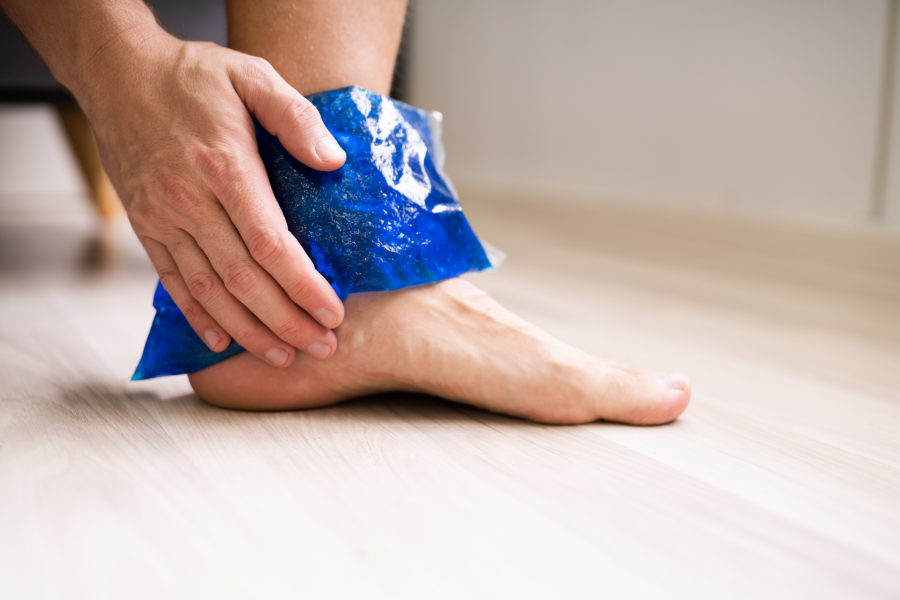Should I put ice on an injury?
- mtscait
- Aug 23
- 4 min read
Should I put ice on an acute injury? I am constantly asked this question in the clinic and when working with athletes on the field or track. I always like to give advice based on actual research plus meeting the person where they are at, so lets dive in!

What is RICE?
RICE: Rest, Ice, Compression, Elevation. The age old saying that every parent, doctor, and coach told you after you rolled your ankle…but is that the most effective way to treat it?
Is RICE the best advice?
The short answer: probably not!
Using the example of a sprained ankle: you roll your ankle running, it swells up and is a little black and blue, but you can still walk on it with 3/10 pain. X-rays show no fracture, you are diagnosed with a simple ankle sprain. What should you do?
The point of RICE was to decrease swelling and pain. Laying off the joint will decrease the stress there, ice will cause vasoconstriction (tightening of the blood vessels = less blood to the area = less fluid in the area), compression creates a physical barrier to the fluid, and elevation helps the fluid move through the system back to the heart.
Now, let's dissect each piece:
Rest:
Current research actually shows that TOTAL rest isn’t good for healing things. Controlled movement is helpful! For the ankle sprain example, the calf is the main pump to move fluid out of the lower leg, so contracting the calf can be very helpful to manage ankle swelling.
Ice:
Current research shows ice can stop the body’s natural healing process, aka it could delay healing. Most of the research says - it probably doesn't make a difference if you ice or not.
Compression:
This continues to be in favor - compression can improve pain and mobility in an injured joint.
Elevation:
Again, continues to be in favor. The vascular and lymphatic systems (the fluid systems) in our bodies are gravity dependent, meaning the fluid will pool down away from the heart. By elevating above your heart, you can help that fluid move away from the injury.
So…what can you do to help?
Relative Rest:
Your ankle hurts to walk, so you definitely shouldn’t run. But you can bike without pain. Movement, while still avoiding provocative activities, can be really helpful for healing.
Protected Movement:
Move your ankle as much as you can without increasing pain. Gentle range of motion exercises like ankle pumps can be a great option.
Bonus: remember about how the fluid systems in our body are gravity dependent? Well the other thing that pumps fluid out of the legs is the muscles! Doing things like calf raises can help move fluid up and out - decreasing swelling.
You can also do range of motion exercises while elevating!
Compression and Joint Protection are still helpful. An ankle brace is a great way to protect the joint as the ligaments heal, all while providing some compression.
When does ice make a positive impact? If you have an injury that has resulted in significant swelling, ice can likely help decrease that swelling. Too much swelling could impact healing too!
Should I use ice for chronic pain?
Short answer: probably, if you find it helpful!
There is research showing that ice can actually be really helpful for pain relief with chronic pain.
The idea with ice application is that it will impact our central nervous systems for chronic pain. Feels free to check out this article explaining it all.
Some will find that ice is helpful, while others will find it makes them stiff. For that group, often trading the ice for heat application can help with pain and decrease the stiffness.
Bottom Line on Ice?
What I tell my patients is, if you LIKE ice and how you feel after using it...go for it! But if you're just doing it because "they" say to, you don't necessarily have to. The research doesn't clearly point to ice being bad and harmful, just that it probably doesn't do anything. Where the "harm" comes into play is completely cutting out all movement and exercise when there is no reason to.
Personally, when I put ice on certain parts of my body I feel worse, more tense, stiff, and just cold! I have had my share of injuries so I know when I'll respond in a positive or negative way to ice.
Some references:
About the author: Dr. Caitlyn Hauswirth-Varis, PT, DPT, OCS, CFMT, CF-L1

Caitlyn is a board certified orthopedic physical therapist and pelvic floor specialist. Beyond her PT degree and accolades, she is a track and field coach and Pregnancy and Postpartum Exercise Specialist. She has worked with athletes at all ages and stages and has been a lifelong athlete herself. She has competed on a D1 college team and at the national and semi-pro level.
Disclaimer: This blog post is for informational purposes only and does not substitute for professional medical advice. Please consult with a qualified healthcare professional for personalized guidance.
.png)



Comments